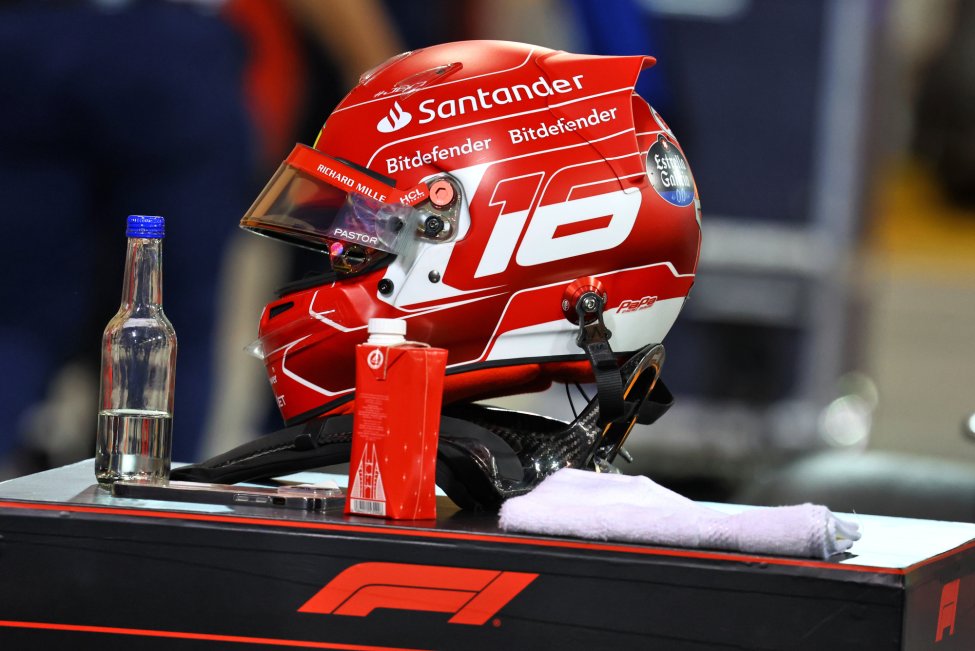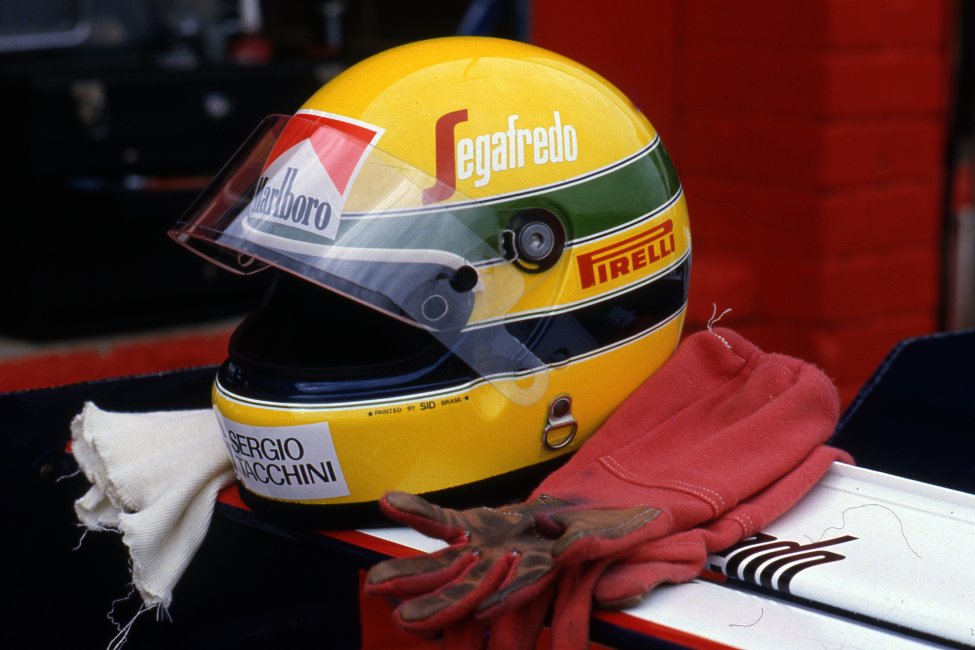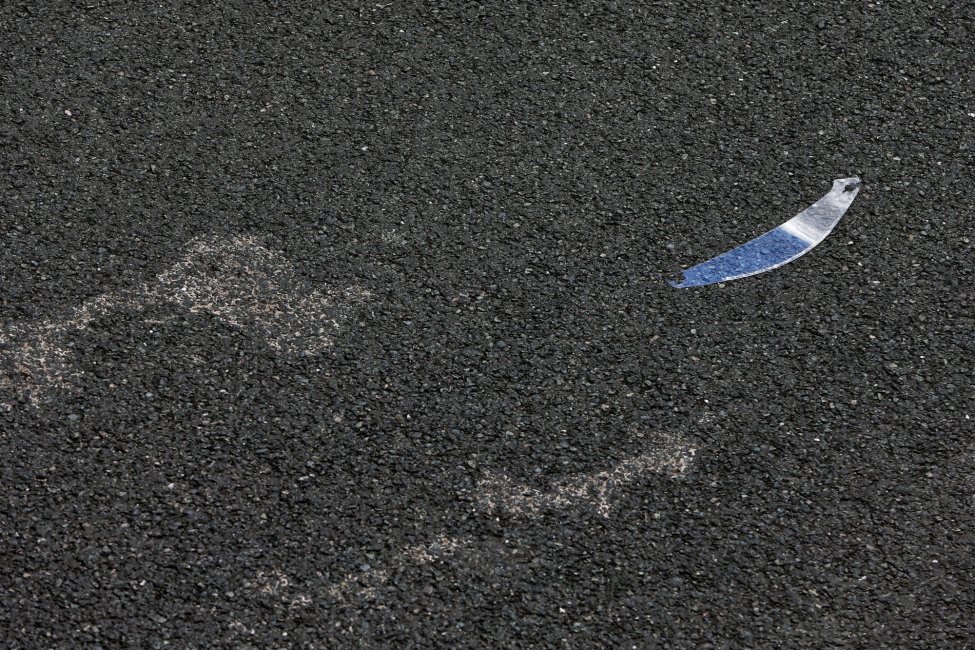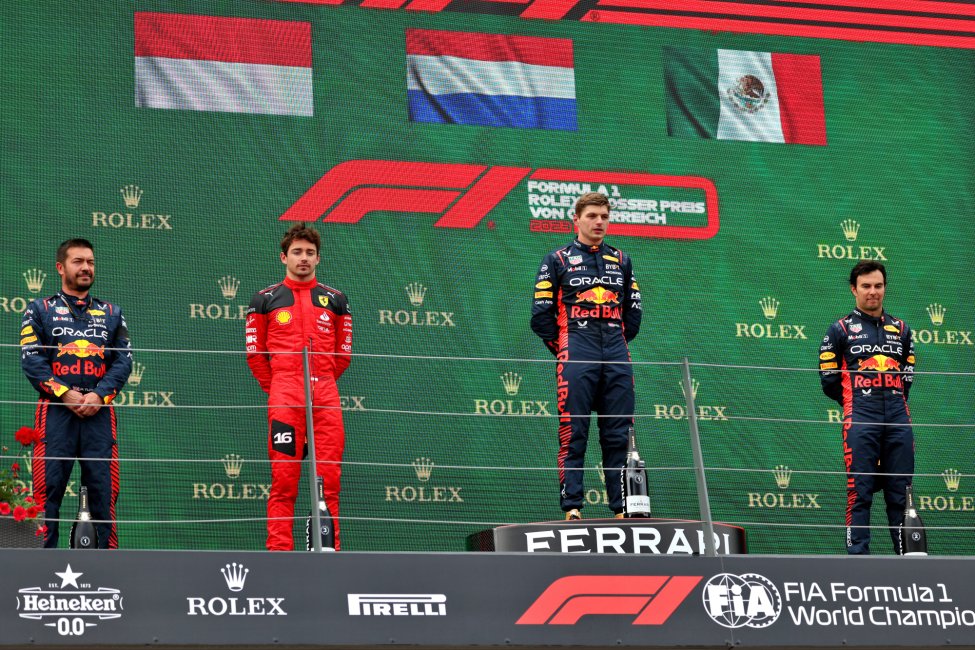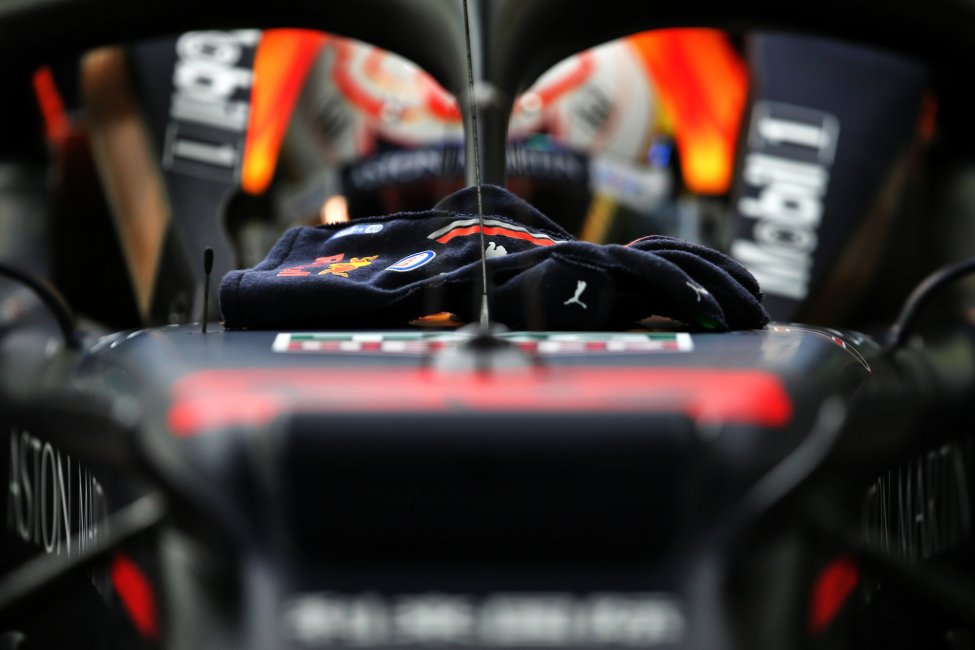F1 driver equipment
What do Formula 1 drivers wear? How safe is the racing suit and what is the HANS system? Read all about it here.
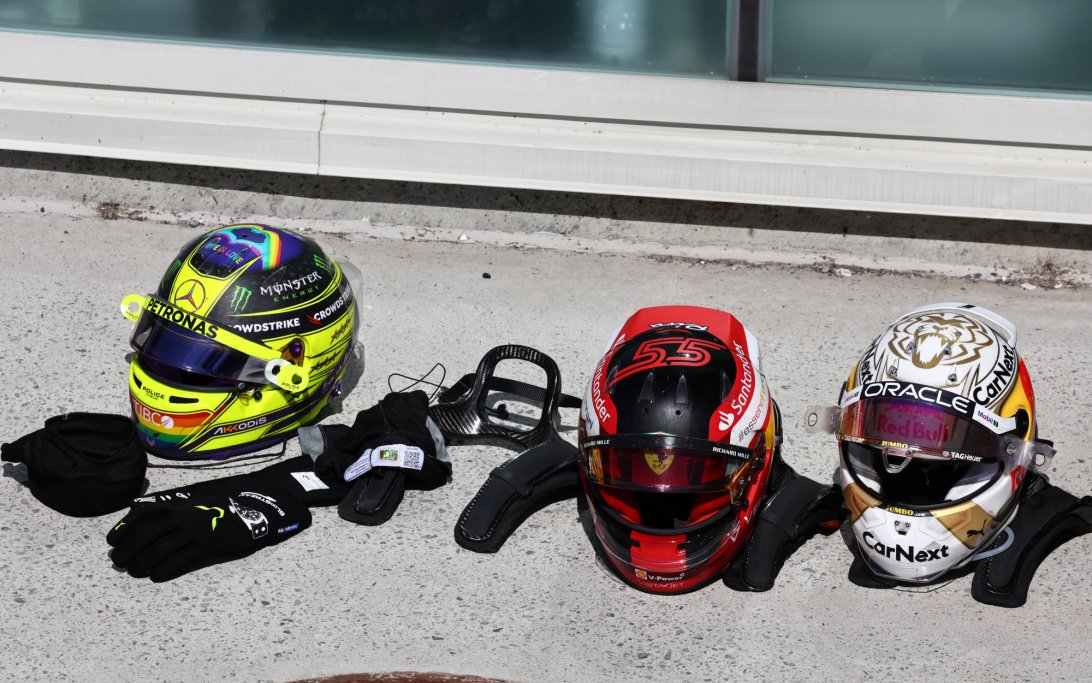
F1 helmet
The first racing helmet was introduced in the 1930s. In the beginning, a helmet was often nothing more than a cotton or leather hood. There was no visor; people often put on loose goggles. In the 1950s, helmets began to look a bit more like the design we know today. Hard materials such as leather and cork with a synthetic outer layer were used for the first time. At this time, helmets covered only the skull. The ears and the rest of the face were not protected. In 1954, the Bell company designed a hardened helmet consisting of fibreglass-reinforced plastic. This was lined with foam. Metal helmets from the Buco brand also appeared. Over time, leather flaps were added to cover the ears.
The first time anyone drove with a closed helmet was on the Zandvoort circuit. American driver Dan Gurney tested with it in 1968. Two weeks later, the design was raced for the first time, during a Formula 1 race at the Nürburgring.
F1 helmets today
Contemporary Formula 1 helmets not only provide protection in the event of a (severe) crash. They also protect a driver from stray objects. Several drivers in the past suffered permanent injuries at the hands of loose objects on the track. One of the most famous events is when Dr. Helmut Marko got a stone in his eye, leaving him blind in one eye.
Nowadays, a helmet offers more than just protection. Thus, a helmet also serves for:
- Aerodynamics
- Integration of a hydration system
- Integration of radio communication
- Sponsorship opportunities
Every helmet within Formula 1 is custom-made. Using special software, they scan the contours of an F1 driver's head. Based on this, an inner liner is designed for the fit using fireproof foam. The outside of the helmet is produced from carbon fibre, which provides the strength of the helmet. The helmet is finished by kevlar, which protects the rider from sharp objects and high temperatures.
The HANS system is also an important part of the F1 helmet. You can read exactly what a HANS system is on this page.
How much does an F1 helmet cost?
A Formula 1 helmet costs between €4.000 and €7.000, Verstappen.com reported in 2020. On average, a driver wears 12 different helmets per season. However, drivers do not pay for their helmets themselves. The team and/or sponsors generally supply the helmets.
What should an F1 helmet comply with?
After the accident Felipe Massa experienced at the 2009 Hungarian Grand Prix, strict safety regulations for racing helmets in Formula 1 were introduced. The so-called helmet test was introduced in 2018 and consists of the following components, in which:
- A 10-kilogram weight is released from a height of five metres onto the side and top of the helmet;
- Testing whether the helmet is meant to withstand temperatures of up to eight hundred degrees Celsius. In addition, the flames should extinguish on their own;
- The part under the visor takes hits. It is checked whether this part of the helmet absorbs the blows without too much energy going to the driver's head;
- One pulls on the buckle to check that the helmet does not come off;
- 1.2 g bullets are shot at the visor with an air gun;
- One checks that the driver's head is not exposed to more than 275G at high speed and 200G at lower speed when there is a frontal or side impact;
- The so-called Mass test is performed. A 225-gram projectile is fired at various points on the helmet. This is done at a speed of 250 kilometres per hour.
Eye-catching helmets in Formula 1
F1 drivers drove with different eye-catching designs over the years. For example, Ayrton Senna could always be recognised by his yellow headgear, Sebastian Vettel once drove with LED lights in his helmet and Lando Norris had a helmet that looked like a beachball at the 2023 Miami Grand Prix.
Read more about the most iconic helmets of the 2022 season here.
Tear-offs F1
What are tear-offs? Tear-offs are thin plastic layers stuck over the visor of a Formula 1 driver's helmet. When the visor gets dirty, from insects for example, the driver can easily peel it off, improving visibility again. This provides a piece of safety and the Formula 1 driver does not have to stop to change or clean his helmet, for example. At the start of the race, several layers are stuck over the helmet to ensure good visibility throughout the entire Grand Prix.
Problems with tear-offs
Tear-offs can also occasionally cause problems. For example, a tear-off from Max Verstappen's helmet got into the front brakes of Charles Leclerc's Ferrari during the 2022 Belgian GP. With the brakes no longer receiving cooling, they were in danger of overheating. Leclerc would like to see another solution of depositing the tear offs, such as leaving them in the car instead of throwing them on the track. Incidentally, the rules do state that you cannot 'unnecessarily' throw a tear off on the track. However, this rule is not entirely enforced.
Racing suit
The racing suit worn by the Formula 1 driver must, of course, provide adequate protection. Among other things, it is important that the racing suit is fireproof, it provides protection against heat and protects the driver during possible crashes. What is a Formula 1 suit made of? The material used for the outer layer is called Nomex. This is fireproof material and can withstand high temperatures. The inner layer is made of a material that regulates moisture, which is very important to keep it comfortable for the driver. The racing suit also contains additional padding and stitching to provide even more strength and comfort. In addition, there are two shoulder straps attached to the racing suit, allowing the Formula 1 driver to be pulled out of the car in an emergency.
Each driver has personalised racing suits that feature the driver's name, number and national flag, as well as the team's logo and colours. In addition, the suit is full of sponsorships. Drivers have several racing suits available for an entire Formula 1 season to ensure safety.
Undergarments
The material of the undergarments worn by the Formula 1 driver is also made of the fire-resistant material Nomex. This should protect the driver from high temperatures and burns, but should also ensure that sweat is drained and body temperature is regulated. The underwear can also provide extra protection to the ribs.
Gloves F1
Formula 1 drivers wear special gloves when they are in the cockpit. These are essential for both driver safety and performance on the track. They are designed to provide optimum grip and steering control, even in extreme conditions, of course.
Ergonomic, durable and fireproof
The gloves are made of lightweight and durable material. In addition, the breathable properties ensure that drivers' hands remain cool and comfortable during races. After Romain Grosjean's crash at the 2020 Bahrain Grand Prix, they started developing even better, heat-resistant gloves. The inferno Grosjean ended up in after his violent crash caused the necessary burns on the Frenchman's hands. The FIA ordered new fire-resistant gloves to be designed after the accident. Daniel Ricciardo used the new gloves for the first time, at the 2021 Turkish Grand Prix. Formula 1 drivers' shoes are also made of durable and lightweight material and offer maximum grip through the sole.
Biometric gloves in Formula 1
Formula 1 also adopted a modern version of the classic glove in 2019. Since that year, it has been mandatory that a driver's gloves contain sensors, which send various vital signs of the drivers to the medical team.
F1 shoes
Racing shoes are crafted from special material that provides protection against significant forces and fire risks. Furthermore, they are extremely lightweight and incredibly durable. Thanks to the minimally textured sole, the driver has optimum control over the pedals.
Shoes Max Verstappen and Sergio Perez
At the Spanish Grand Prix, Verstappen unexpectedly swapped his blue Sparco shoes, which he had worn during the first six races of this season, for gold Puma shoes. These were identical to the shoes with which he won fifteen Grand Prix titles in 2022. This change was not due to his preference for gold-colored shoes, but primarily due to his impatience with Sparco, his Italian equipment supplier. This is corroborated by the fact that he was suffering from sore feet. His teammate from Mexico had already experienced these discomforts earlier. Red Bull announced at the end of last year that they would choose a new clothing sponsor after seven seasons with Puma.
The Austrian racing team entered into a collaboration with the sports brand Castore for their team clothing. However, Castore has no experience with racing gear, so Red Bull had to look for another supplier. Their search ended with the renowned Italian company Sparco, which has specialized in the manufacture of racing suits, shoes, and other necessities for drivers for over four decades, with the exception of helmets. Despite the initial joy of the Italians in securing the world champion team, they are now facing major challenges. They seem unable to meet the needs of Pérez and Verstappen.
Don't miss out on any of the Formula 1 action thanks to this handy 2026 F1 calendar that can be easily loaded into your smartphone or PC.
Download the calender